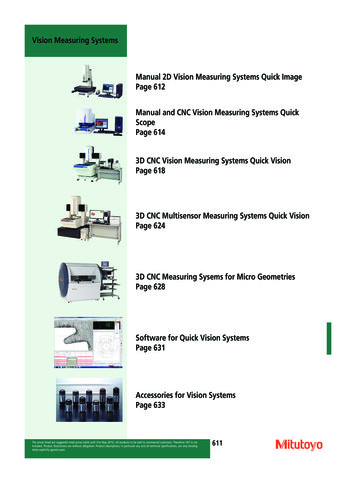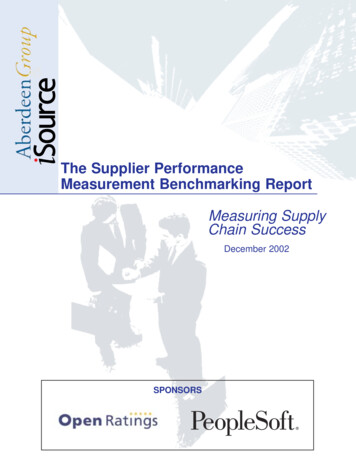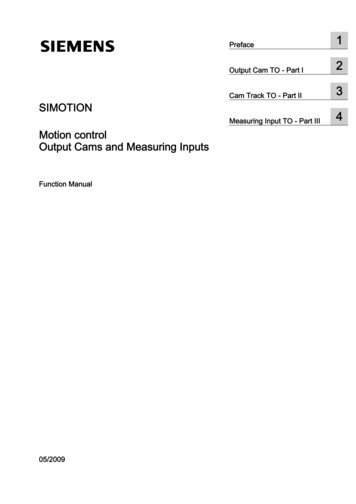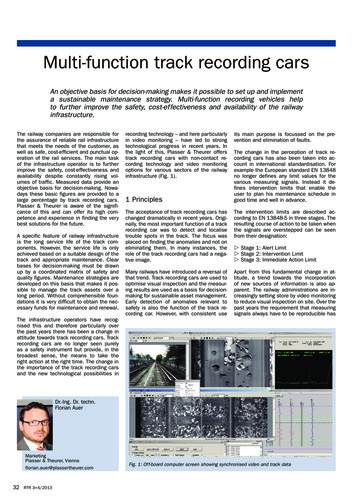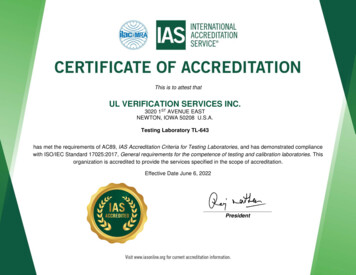
Transcription
DEGREE PROJECT IN MECHANICAL ENGINEERING,SECOND CYCLE, 30 CREDITSSTOCKHOLM, SWEDEN 2018Measuring Performance ofan Order-to-Delivery ProcessA study at Scania CV ABPHILIP SUNDSTRÖMKLARA TOLLMARKTH ROYAL INSTITUTE OF TECHNOLOGYSCHOOL OF INDUSTRIAL ENGINEERING AND MANAGEMENT
Measuring Performance of anOrder-to-Delivery Process- A Study at Scania CV ABPhilip SundströmKlara Tollmar2018Supervisor: Daniel Tesfamariam SemereExaminer: Andreas ArchentiKTH Royal Institute of Technology in Stockholm
School of Industrial Engineering and ManagementAcknowledgementsThis thesis project is performed as the final part of our master’s degree in Production Engineering andManagement at the KTH Royal Institute of Technology in Stockholm, Sweden. The thesis wasconducted at Scania CV AB in Södertälje.First of all we would like to thank Scania for welcoming us and for giving us this opportunity. We wantto acknowledge all of those that we have met at the company and who have answered our questionsand given us their time and knowledge. This acknowledgement and gratitude is also extended to theinterviewed companies that have participated in our thesis. Above this, we especially want to thankour supervisor, Libna Monteiro, who have supported and helped us in our work. We also want toextend our gratitude to Per Hedlund, the responsible manager, and Daniel Sterner for initiating thisthesis project. Lastly we want to thank our KTH supervisor Daniel Semere for his help, time andknowledge. Without all of you this thesis would not have been possible.Södertälje, SwedenJune 2018Philip SundströmKlara Tollmar
AbstractThe Order-to-Delivery (OTD) process covers the entire flow from an initiated order until the productor service is delivered to the customer. OTD is considered a core flow in order to successfully deliverproducts according to the customer’s needs. Therefore, is it of importance to track the performanceof this flow and all intermediary processes through performance measurements. The key to successfulperformance measurement is to identify critical factors that can be measured towards previous states,future goals and industry best-practices. However, there are no standardized solutions that can beadopted. Instead performance measurements need to be adapted to each organization’s capabilities,limitations and needs. Effective performance measures and indicators can help steer a company in theright direction.In this thesis, Scania’s industrial OTD process and the connecting indicators has been studied. Thecompany would like to know possible indicators to measure the performance of this process so that itwill contribute to find deviations, continuous improvement and challenge the current state. There isalso a need to increase the knowledge of how to interpret and manage indicators.The project has been conducted through both empirical and theoretical studies. An extensive literaturereview has been performed. The study concluded in methods and best practices for performancemeasurements, as suggested by literature. It has also resulted in an identification of relevant OTDmeasures. Empirical studies have been conducted through a current state analysis of Scania and acompany comparison. Five companies were interviewed on the topic of performance measurements.The aim was to identify the measurements used in each of the companies OTD flow and to investigateif any best practices could be identified. The empirical findings have been analyzed towards thetheoretical findings in order to find gaps and improvement suggestions. It was found that lead timeand delivery performance are two strategic elements to evaluate a company’s OTD flow.Lastly, a concept has been developed as an additional approach to measure the part of a lead timethat has the largest variance - transport time. The concept can, with further work, be extended toinclude the entire lead time. The aim with the concept was to fairly compare different transport timesagainst each. It is believed that the approach can be used as a tool to visualize the efficiency of thetransport flow to different delivery countries and therefore determine if the country behavesaccording to a normal situation.The thesis has resulted in recommendations to implement new measures that could be of value toScania. Process wise it is suggested to better differentiate between indicators and to improve the waythey are presented and reported. It is also suggested that that quality of the input data and thereporting process for this should be reviewed.KeywordsLogistics, Supply Chain Management, Order-to-Delivery, Performance Measurements, KeyPerformance Indicators, Lead Time, Delivery Performance
SammanfattningOrder till leverans-processen täcker hela flödet från orderläggning tills att slutprodukten eller servicenlevereras till kund. Processen anses vara en kärnprocess och är kritisk för att kunna leverera produkterenligt kundens behov. Det är därför viktigt att följa upp prestandan av detta processflöde genom olikaprestationsmått. För att lyckas med prestationsmätning är det viktigt att identifiera kritiska faktoreroch mäta dessa mot tidigare lägen, framtida mål och best practices inom industrin. Det finns dock ingastandardiserade lösningar som kan implementeras på företag. Prestationsmått måste anpassas eftervarje organisations kapacitet, begränsningar och behov. Genom att använda effektiva prestationsmåttoch indikatorer kan ett företag styras i önskvärd riktning.I detta examensarbete har Scanias industriella order till leverans-process och dess tillhörandeprestationsmått studerats. Företaget har en önskan om att identifiera möjliga indikatorer för att mätaprestandan av order till leverans-processen, vilket kan bidra till att hitta avvikelser, ständigaförbättringar och att utmana den nuvarande situationen. Det finns även ett behov av att ökakunskapen om hur prestationsmått ska tolkas och hanteras.Detta projekt har utförts genom empiriska och teoretiska studier. En omfattande litteraturstudie harresulterat i lämpliga metoder och utföranden gällande prestationsmått. Studien har även resulterat irelevanta order till leverans-mått enligt akademisk forskning. De empiriska studierna har bestått av ennulägesanalys av Scania och en jämförelsestudie där fem olika företag har blivit intervjuade inomämnet prestationsmätning. Målet med jämförelsestudien var att undersöka de olika mått somföretagen använder i sin order till leverans-process och för att ta reda på hur de arbetar medprestationsmätning. De empiriska studierna har analyserats i förhållande till teori, för att hittakunskapsluckor och förbättringsförslag. Det kan konstateras att ledtid och leveransprestanda är tvåstrategiskt viktiga faktorer för att kunna utvärdera ett företags order till leverans-process.Slutligen har ett nytt ledtidskoncept blivit utvecklat. Konceptet mäter transporttiden, vilket är den delav ledtiden där störst variation uppstår. Konceptet har potential att utvecklas och förlängas till att mätaden totala ledtiden. Målet med konceptet var att jämföra olika transporttider på ett rättvist sätt motvarandra. Konceptet kan användas som ett verktyg för att visualisera effektiviteten av transportflödettill olika leveransländer och därav avgöra om landets processer presterar enligt ett normalläge.Examensarbetet har resulterat i rekommendationer om att implementera prestationsmått som kanskapa värde för Scania. Det rekommenderas också att särskilja olika typer av prestationsmått samtförbättra hur dessa presenteras och rapporteras. Även kvalitén på indata och hur data rapporters börses över.NyckelordLogistik, försörjningskedja, order till leverans, prestationsmått, nyckeltal, ledtid, leveransprestanda
Table of ContentsINTRODUCTION. 1Background. 1Problem Description. 2Purpose . 21.3.1Research Questions . 2Delimitations . 3METHODOLOGY . 4Research Approach . 4Data Collection . 42.2.1Literature Study . 52.2.2Internal Presentations . 52.2.3Interviews . 5Reliability, Validity and Objectivity . 6THEORETICAL FRAMEWORK . 8Supply Chain Management . 83.1.1Hierarchy Levels of a Supply Chain . 93.1.2Supply Chain Effectiveness & Efficiency. 9Order-to-Delivery Process . 103.2.1Order Lead Time . 113.2.2Delivery Performance. 12Measuring Performance. 123.3.1A Historical View on Measuring Performance . 123.3.2Definitions . 13Performance Management . 133.4.1Performance Management Maturity . 14Performance Measures and Indicators . 143.5.1Leading and Lagging Indicators . 17Different Measurement Levels . 173.6.1Aligning with strategy. 183.6.2Correlation between KPIs. 19Methods for Performance Measurements . 193.7.1Performance Measurement System (PMS). 203.7.2SCOR Model. 21Supply Chain Measures and Indicators . 233.8.1Identified Order-to-Delivery Measures and Indicators. 23Developing and Reporting Measures and Indicators . 263.9.1Development of Key Performance Indicators . 263.9.2Performance Analysis . 273.9.3Defining and Reporting Measurements . 29COMPANY DESCRIPTION . 32Company Introduction . 32The Scania Way . 324.2.1Scania’s Core Values . 32
4.2.24.2.3The Thinking Model . 33The Scania House . 33CURRENT STATE ANALYSIS . 35Scania’s Order-to-Delivery Process . 355.1.1Flow Control . 36Measuring Performance on Strategical Level . 37Measuring Performance within Order-to-Delivery at Scania . 375.3.1Average Lead time. 375.3.2Ideal Flow . 405.3.3Delivery Precision . 41COMPANY COMPARISON . 43Overview of Company Comparison . 44Audi AG . 44MAN Truck & Bus AG. 47SSAB AB . 50Sandvik AB . 54Volkswagen AG . 56DEVELOPMENT OF A PERFORMANCE MEASUREMENT CONCEPT . 60Introduction. 60Step 1 - Describe Intended Results . 60Step 2 - Understand Alternative Measurements . 637.3.1Normalize Transport Time . 63Step 3 - Select the right measures from objective . 67Future work . 68ANALYSIS . 69Methods and Best Practices . 69Suitable OTD Performance Measures . 71Company Comparison . 72Development of a Performance Measurement Concept. 75CONCLUSIONS AND RECOMMENDATIONS . 77Conclusions. 77Recommendations . 82REFERENCES . 84List of interviews . 88APPENDIX 1 – INTERVIEW QUESTIONS . IAPPENDIX 2 – IDENTIFIED CLUSTERS . III
List of figuresFigure 1: Delimitation of the project scope. The abbreviation DE stands for dealer and DI stands fordistributor in the figure. . 3Figure 2 : The figure illustrates the thesis focus structure. . 4Figure 3: From left to right, low reliability and low validity, high reliability but low validity and highreliability and high validity. Source: Adapted from Björklund and Paulsson (2003). . 6Figure 4: Supply chain process. Source: Swaminathan (2001). . 8Figure 5: Different aspects of lead time. Source: Forslund, Jansson & Mattson (2008). . 11Figure 6: The continuous circle of performance management. Source: Eckerson (2009). . 14Figure 7: The onion analogy Badawy, El-Aziz, Idress, Hefny & Hassam (2016). . 16Figure 8: Measurements seen from different levels of aggregation. Source: Slack, Brandon-Jones,Johnston & Betts (2015). . 18Figure 9: How KPIs are aligned with strategy. Source: Asif (2017). . 18Figure 10: The Score model according to APICS. Source: APICS (2017). . 21Figure 11: KPI development process. Source: Rohm and Nisbet (2018) . 26Figure 12: Targets and thresholds. Source: Rohm and Nisbet (2018) . 27Figure 13: Performance analysis process according to Balanced Scorecard Institute (2018) . 28Figure 14:The four perspectives of a Balanced Scorecard. Adapted from: Slack, Brandon-Jones,Johnston & Betts (2015). . 30Figure 15: Scania’s thinking model. Adopted from Palmgren (2013). . 33Figure 16: The Scania House. Source: Scania (2018) . 34Figure 17: The figure shows the main functions at Scania and the core cross-company flows. Source:Scania (2017). . 35Figure 18: Overview of Scania’s OTD process. Source: Scania (2017). . 36Figure 19: Flow control implementation process. Source: Scania (2017). . 36Figure 20: The figure shows a representation of Scania’s Balanced Scorecard. Source: Scania (2018). 37Figure 21:The lead time and belonging dates . 38Figure 22: Example of a graph showing no of individuals within (OK) or outside the parameter (notOK). . 40Figure 23: The figure shows examples of lead times that are comparable and lead times that are notcomparable. . 63Figure 24: The plot shows the normalized transport time vs the normalized efficiency. . 65Figure 25: The plot shows the average transport time vs the average efficiency. . 65Figure 26: Identified clusters. . 66
List of tablesTable 1: Effectiveness and efficiency described in a matrix. . 10Table 2: Overview of indicators. Source: Parmenter (2015). 16Table 3: The five types of performance attributes and belonging level 1 metrics. Source: APICS (2017). 22Table 4: Eight types of performance measurement. Source: Petterson (2008). . 23Table 5: Identified OTD measures. Source: Keebler & Plank (2009), Gunasekaran, Patel &McGaugheyc (2004), Gunasekaran, Patel & Tirtiroglu (2001), Fraser, Manrodt & Vitasek (2008),Hausman (2002), Fast (2015) and Forslund, Johnsson & Matsson (2008). . 24Table 6: Example of a definition sheet. Adapted from kpi.org and Neely et al. (1997) . 29Table 7: The differences between BSC and Dashboard. Source: Mihai & Zamfir (2014) and Savkin(2017). . 31Table 8: The table compiles all dates used in the lead time measurements. 39Table 9: Interview information . 43Table 10: An overview of the performance measurements found during the interviews. . 44Table 11: A summary of key point of why lead time should be measured. . 62Table 12: A summary on key points of what the lead time measurement should show. . 62Table 13: The different concept evaluated towards the stated objectives. . 67Table 14: Measurements that exists, not exists, and that are not suitable or out of scope. . 72Table 15: Existing and non-existing measures . 78Table 16: The cross-functional OTD measurements at Scania . 80Table 17: A comparison between Scania processes and identified best practices. . 80Table 18: Performance measurements at the compared companies . 81
AbbreviationsADD – Actual Delivery DateARD – Actual Release DateATA – Actual Time of ArrivalBC – Batch closedBSC – Balanced ScorecardCBU – Completely built upCDD – Confirmed Delivery DateCO – Commercial OperationsCRD – Confirmed Release dateDDD – Desired Delivery DateDTL – Delivery Time ListEA – End AssemblyF&BC – Financial services & business controlFD – Finished dateFOD – First Order DateKAP – Kundenauftragsprozess (German expression for Order-to-Delivery process)KD – Knock downM.O.D – Mathematical order dateOTD – Order-To-DeliveryP&L – Production and LogisticsPDD – Preliminary Delivery DatePRU – Production UnitR&D – Research & DevelopmentS – PurchasingST1 – Status 1S&M – Sales & Marketing
IntroductionThis chapter introduces the background of the thesis. It highlights the problem description that has ledto the creation of this thesis project. Following this it defines a purpose for the project and the researchquestions that have been formulated to approach it. Lastly the chapter states the delimitations for theproject and gives an overview of the report structure.BackgroundScania is a global company, with sales and services in more than 100 countries. In 2017 the companyproduced and delivered 82 472 trucks and 8 305 buses (Scania, 2018). Apart from this Scania alsodelivered industrial and marine engines, spare parts and other components to customers (Scania,2017). To be able to do this, Scania has a network of complex processes and flows within the company.One of the core flows in order to successfully deliver according to customer demand is a company’sOrder-to-Delivery process (Forslund, Jonsson, & Matsson, 2008).The Order-to-Delivery (OTD) process is the entire flow from an initiated order until the product orservice is delivered to the customer. This includes all intermediate processes that are required in orderto fulfil the customer need. Scania qualifies their Order-to-Deliver process as one of the critical flowswithin the company. They recognize that the performance of the OTD process is of utter mostimportance for the success of the company.According to Catasús et al. (2008) are companies always looking for success factors and ways toperform better. But how can a company determine when they have accomplished improvements.Catasús et al. (2008) argues that it is difficult or even impossible to steer a company towards successalone. However, one can steer a company with the use of different factors that are believed toaccomplish success. These factors can be measured and compared towards previous states, futuregoals and industry best-practices. This process is referred to as performance measurement (Neely,Mills, Gregory, & Platts, 1995). Parmenter (2015) argues that appropriate performance measurementscannot only help to steer the organization towards its intended goals but it can also help create a widerownership where employees can clearly see the progress and by that motivate actions. Performancemeasurements are also a useful tool in decision-making, but it does not only have positive impacts. Ameasurement can have unintended effects by encouraging wrongly behavior or even steering thecompany in the wrong direction. Since there are no general success factors, are there no standard wayor solutions to work with performance measurements. Parmenter (2015) further argues that manycompanies work with the wrong type of measure and that the commonly used Key PerformanceIndicator may not have the intended purpose.It is important for a company to define the measurements that are relevant for their specific companyaccording to their own processes and targets. Therefore, Scania wants to be better at working withmeasurements in order to handle deviations and drive improvements within their Order-to-Deliveryprocess. However, it is not a straightforward task to measure and determine how well the process isin fact performing due to the length and complexity of the OTD process.1
Problem DescriptionToday, Scania use so called Key Performance Indicators (KPIs), which can allow to analyze the currentstate towards a defined target or baseline. There are three different KPIs measured within their OTDprocess, when looking at an end-to-end perspective. The indicators measured are the following: Lead timeDelivery precisionStock levelHowever, Scania themselves states that they have difficulties interpreting these measurements andhow to use them to drive the process forward. They express a need to better understand and workwith measures and indicators in the OTD process. Employees want to better recognize what themeasurements mean to the company and how to work with them in order to handle deviations anddrive performance. Some problems stated at Scania today are:“We need to be better on measuring and follow up KPIs”“We want to understand KPIs”“What do they actually indicate?”“What should we do with them?”Investigating other ways to measure and manage the OTD process can help Scania bring in new ideasand viewpoints to improve their performance measurement processes, with their own values, goalsand processes in mind.PurposeThe purpose of this thesis is to study performance measures and indicators in the Order-to-Deliveryprocess, in order to achieve and meet the statements mentioned above. The aim is to find bestpractices and alternative measures by performing an extensi
It is also suggested that that quality of the input data and the reporting process for this should be reviewed. Keywords Logistics, Supply Chain Management, Order-to-Delivery, Performance Measurements, Key . Figure 20: The figure shows a representation of Scania's alanced Scorecard. Source: Scania (2018).


